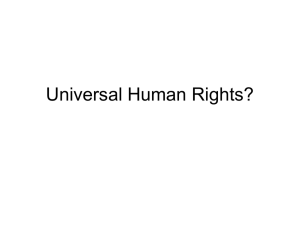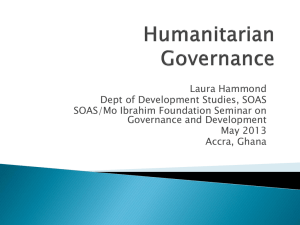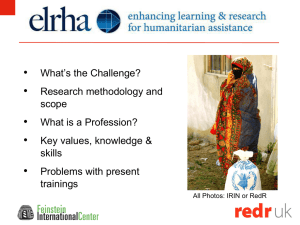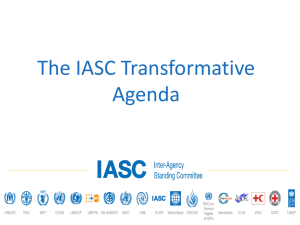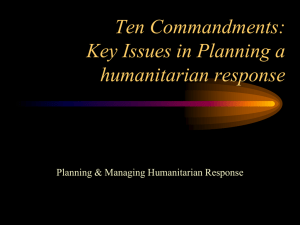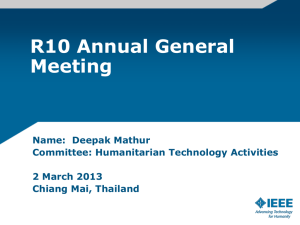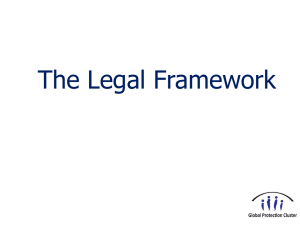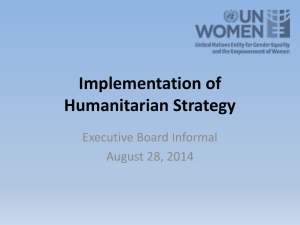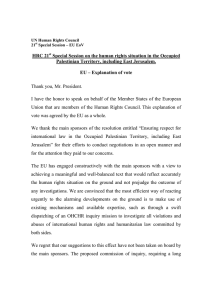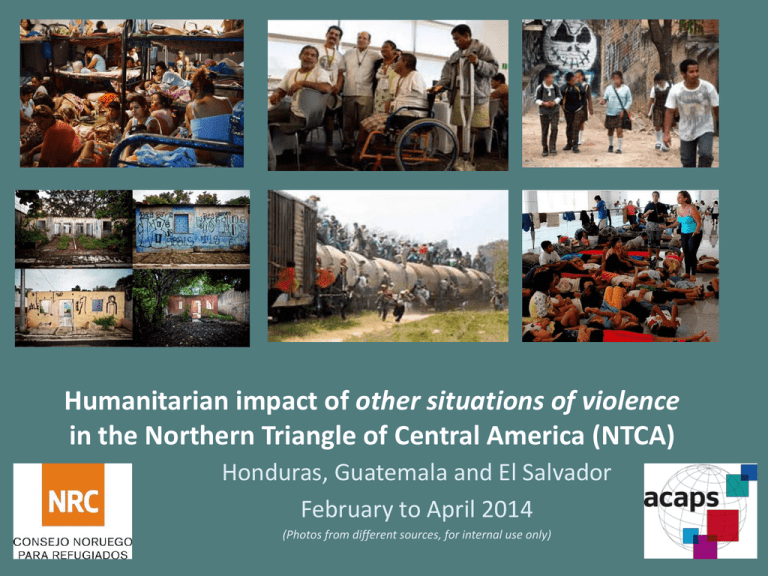
Humanitarian impact of other situations of violence
in the Northern Triangle of Central America (NTCA)
Honduras, Guatemala and El Salvador
February to April 2014
(Photos from different sources, for internal use only)
BACKGROUND AND OBJECTIVES
BACKGROUND:
Impact of OSV critical in the TNCA: NRC requested technical support from
ACAPS (NRC + Save the Children + AAH)
2-person team deployed to Panama and NTCA for three months:
conducting SDR (300+ documents, videos and news) and KI interviews (90+)
OBJECTIVES
1. To improve the understanding of the humanitarian impacts of violence on
the lives of the affected population, using a multi-sectoral approach and
considering both direct and indirect effects.
2. To identify and propose specific sectoral indicators to measure these
impacts (identifying available sources at national or regional level).
3. To provide an analytical framework (for humanitarian actors to decide on
the relevance of humanitarian responses ) and to recommend next steps
HOMICIDES RATES WORLDWIDE (2012)
UNODC: Homicide rate per 100,000 persons (2012)
Average worldwide
6.2
Afghanistan
6.5
Mali
7.1
Iraq
8
Somalia
8
RCA
11.8
Congo
12.5
Rwanda
23.1
RDC
28.3
Sudafrica
31
Guatemala
El Salvador
South Sudan* (2013)
Honduras
39.9
41.2
60
90.4
2013 EPIDEMIC LEVELS OF VIOLENCE IN THE TNCA:
2013: 15,000 Homicides = 41.9 homicides per day
(143,588 homicides reported 2004 to 2013. Population 29.7 million people)
TNCA HOMICIDE TRENDS (2004 - 2013)
OSV CONTEXT: SIMILARITIES WITH ARMED CONFLICT
High levels of violence and criminality, high presence and use of
weapons.
Large numbers of injuries caused by firearms (war wounds)
Frequent confrontations (among gangs and with the security forces)
Physical and sexual abuse, torture, extortion, kidnappings,
disappearances
Lack of state rule, high levels of corruption and impunity
Curfews (unofficial), invisible borders, movement restrictions,
confinement
Areas with no state presence/control
Population living in fear of violent death and crime
Limited/no access to health and other basic services, protection
and justice
Forced recruitment (youth and children)
Forced displacement (national and international)
High expenditure in security (public and private expenditure)
Security big business
Access restrictions to assist people in red areas.
Loss of public spaces
Humanitarian impact of other situations of violence in the
Northern Triangle of Central America (NTCA)
Honduras, Guatemala and El Salvador
(ECHO meeting 23/06/14)
(Photos from different sources, for internal use only)
OSV IMPACT: FORCED DISPLACEMENT
Refugiados y solicitantes de refugio del TNCA (2013)
TOTAL Region
Honduras
El Salvador
Guatemala
Solicitantes
Guatemala
2,499
El Salvador
2,405
Honduras
1,462
TOTAL Region
6,366
Refugiados
6,796
8,734
3,047
18,577
OSV IMPACT: VULNERABLE GROUPS
•
•
•
•
•
•
•
IDPS, refugees and asylum seekers, irregular migrants
Young women vulnerable to abuse (sexual, physical and mental), young man
vulnerable to homicide, (victim and perpetrators
Children , youth (unaccompanied IDPS and irregular migrants)
Older people
LGTBI population
People living with disability, chronically ill
LHH: small traders and business, people working in public transport
Need to profile the different affected population groups to understand their needs
better and inform humanitarian actions and response options in the different
geographical areas. Work in coordination with development actors
MEASURING THE HUMANITARIAN IMPACT OF OSV:
CHALLENGES
Underreporting and finding indicators that measure OSV specific
impact (health, displacement, education, etc.
Limitations in access and self-censorship in red areas: Problem and
affected population often remain invisible
Lack of evidence to inform humanitarian decisions/responses
Lack of coordination and approaches among humanitarian actors
(links with development, academia, governments)
Lack of standardised and agreed monitoring systems
Lack of standardised indicators and data collection methodology
Many sources using different methodology and indicator definitions
Limited capacity/willingness to share resources
No expertise and OSV monitoring competencies
MEASURING THE HUMANITARIAN IMPACT:
OSV ANALYTICAL FRAMEWORK
POPULATION STATUS
HUMANITARIAN ACCESS
RESPONSE CAPACITY
Drivers of the crisis (contributing factors)
Population access to assistance
(Limited services available, erosion of social
networks, self-censorship, etc)
National Government response
At national, provincial and
municipal level. Presence and
security forces in some of the red
areas
Pre-existing vulnerabilities
Impacts
(direct and indirect across sectors)
- Health
- Forced displacement), asylum
seekers, refugees and migrants
- Education
- Livelihoods
- Protection
Affected population coping strategies
Magnitude of
affected
population and
vulnerable
groups
Intensity and severity of
the situation/conditions
Access of humanitarian actors to the
population
(Reduced humanitarian space, invisible
borders, negotiating access and security,
etc.)
Security
Risks and threats to people, goods and
infrastructures, security plans, use of
armed escorts (private or state), etc.
Logistic considerations
(Infrastructures, resources, access, etc.)
National non-governmental
response
Red Cross, NGOs, civil society, the
church, private sector, etc.
SCOPE OF THE
CRISIS AND
HUMANITARIAN
PROFILE
Crisis classification
Identification and
ranking of affected
geographical areas
Identification and
ranking of the
vulnerable affected
population
Crisis trends and
evolution
(scenarios)
International response
International humanitarian
organizations, donors, private
sector, etc.
Information gaps
NEXT STEPS:
Generate and use evidence to:
1. Advocate and increase awareness of OSV humanitarian needs
2. Inform humanitarian response and coordination
3. Action generating new evidence
Increase
awareness of
the situation
Humanitarian
needs
response
Advocacy
Evidence

